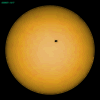

Venus transiting the sun
|
J U N E S K Y W A T C H The most interesting things about the sky in June are the transit of Venus over the sun, two visible comets, and the conjunction of Sun, Moon and Earth so that the gravitation leads to extra high and low tides during the month. The visibility of the planets is minimal. Saturn and Mars are both about to sink below the horizon in the evening, and Mars has been very faint anyway. Venus, of course, is hanging out with Sun, not visible in the night sky. However, it will rise in the morning around mid-month. Keep searching the eastern horizon 30 minutes after sunrise, and see how soon you can spot it. Jupiter is still bright in the southwestern sky, but it is low. It is in the constellation of Leo, and Leo’s brightest star, Regulus, is to the lower right of Jupiter. The comets LINEAR and NEAT are still bright, better than any comet since Hale-Bopp seven years ago. For viewing, go into the dark countryside where you have a clear view of the western horizon. Binocular viewing, from a dark location, can be just fine. There are also sure to be public viewing events hosted by planetaria and astronomy clubs. LINEAR hugs the west-southwest horizon below Jupiter. It must be seen before mid-month, but on the other hand full moon can blot it out early in the month. NEAT is a bit brighter than LINEAR, and climbs higher in the northwest, towards the bowl of the Big Dipper. |